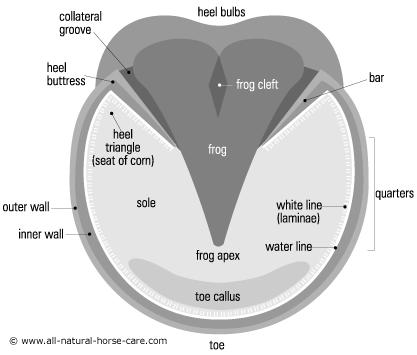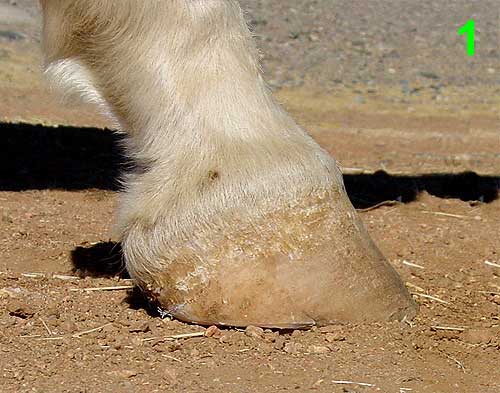Since lameness is a huge factor in hoof rehabilitation, here are two ways to diagnose lameness. In my opinion, each system is equally useful. I find the American Association of Equine Practitioners (AAEP) system useful for a horse showing acute lameness signs. But the Obel system is much more helpful in a horse undergoing hoof problems, since sometimes they don't show that "hitch" at the trot.
AAEP guidelines:0: Lameness not perceptible under any circumstances.
1: Lameness is difficult to observe and is not consistently apparent, regardless of circumstances (e.g. under saddle, circling, inclines, hard surface, etc.).
2: Lameness is difficult to observe at a walk or when trotting in a straight line but consistently apparent under certain circumstances (e.g. weight-carrying, circling, inclines, hard surface, etc.).
3: Lameness is consistently observable at a trot under all circumstances.
4: Lameness is obvious at a walk.
5: Lameness produces minimal weight bearing in motion and/or at rest or a complete inability to move.
Obel lameness grading system:Grade I: At rest the horse will alternately and incessantly lift the feet. Lameness is not evident at a walk but a short stilted gait is noted at a trot.
GradeII: Horses move willingly at a walk, but the gait is stilted. A foot can be lifted off the ground without difficulty.
GradeIII: The horse moves very reluctantly and vigorously resists attempts to have a foot lifted.
GradeIV: The horse refuses to move and will not do so unless forced.
Obviously, with the Obel scale, there is no grade for a sound horse. The Obel scale is great for inflammation, heel pain, etc. I like the wording "stilted" for the gaits. That's the hoof landing flat or toe first.
Right now, Buttercup is like a Grade 1/2 on the Obel. She's not quite stilted at the trot, but she's a little short. She's moving comfortably with no hitch in any gait, so that would put her at a 0 on the AAEP scale.
She has officially gone 48 hours without her turnout boots. She registered a Grade 1 with Obel and a AAEP 1 after the 48 hours, but still looked relatively comfortable. Her frogs have built up to where there is only one finger width of missing frog on the front left and two fingers width of missing frog on the front right. Progress!
We are still waiting on our new EasyBoot Edge boots (just a hint, never order EasyBoots through Country Supply ...). Once we get them, I plan on taking her for long walking trails. She needs a job right now, but no stress. She's feeling good but we don't want her to backslide.



















